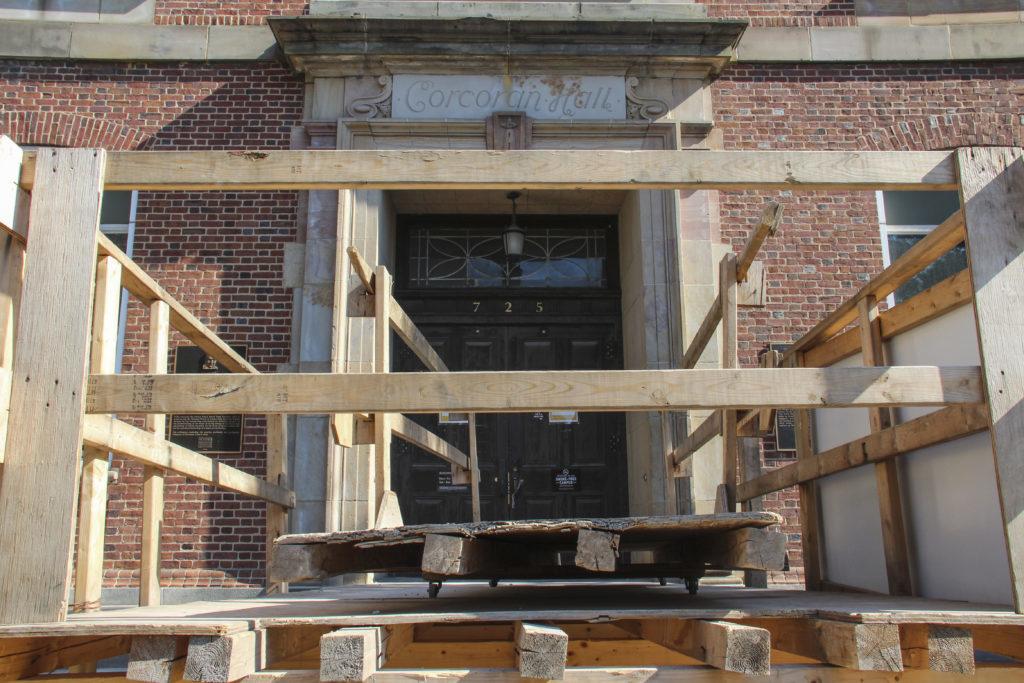Corcoran Hall’s renovations are wrapping up as the physics department prepares to move back into their now updated space.
The physics department will move back into Corcoran Hall early next year to find updated technology in SCALE-UP classrooms, laboratories and work spaces after a $10 million renovation of the aging building. Faculty and students said the renovated building would allow the department to work on more collaborative projects in labs with technology they never had before.
The renovated building will include an advanced physics laboratory in the basement, an optics lab with lasers, two upgraded classrooms designed to be more interactive for large introductory classes — similar to the ones built in the Science and Engineering Hall — and improved offices for professors, Harald Griesshammer, an associate professor of physics, said.
Griesshammer said the third and fourth floor of Corcoran Hall will be dedicated exclusively to the physics department and the bottom two floors will be general classrooms. The space will be designed as much for students to use as it is for faculty, he said.
“The idea is we have space for students just to walk in small groups and work in small groups on any ideas that they have,” he said.
Renovations to Corcoran Hall began in spring 2016 with the aim of giving the physics department a collaborative and efficient space for research and teaching after the department left SEH.
Corcoran Hall was selected after officials conducted a survey to find out how to repurpose space that had been emptied after SEH opened in 2015, University spokesman Brett Zongker said.
“They’re going to make a space that’s really conducive to learning and research and it’s because the University has invested well and been really collaborative.”
“Renovations include creation of new general purpose classrooms suited to an active learning environment, dedicated scale-up classrooms for physics, physics faculty and staff office space, seminar rooms, student study space and new teaching labs,” Zongker said in an email.
Physics faculty will move back into Corcoran in time for the start of the spring semester in January, he said.
Evangeline Downie, an associate professor of physics, said the renovations will give the department more space for collaboration, including the basement lab — which will give physics majors and minors a place to complete projects and labs.
“They’re going to make a space that’s really conducive to learning and research and it’s because the University has invested well and been really collaborative, and we’re really grateful to them,” Downie said.
Downie said the provost’s office and HOK Architects, which is overseeing the renovations, has sought input from the department throughout the process.
“We were extensively consulted about what we needed in the new building and what our priorities were,” Downie said. “We’re going to have this nice refurbished building that also has a cool history of all the things that were done there and all the people who worked there.”
Corcoran Hall has long been the department’s home. The building itself was the first to be built on the University’s Foggy Bottom Campus and nuclear physicist George Gamow taught and conducted research in the building from 1934 to 1956, according to the department’s website.
Kara Zielinski, a senior studying biophysics and a learning assistant, said she and her peers regularly discussed the changes to Corcoran with professors and administrators.
“Everyone is really excited,” Zielinski said. “Having the big conference rooms where students gather, professors walk in and out, and having that type of community feel will translate well to the open floor plan in Corcoran.”
“The main goal was to provide a more appropriate space to do our science and a much more appropriate space to teach our classes.”
Faculty said the renovated building will now include equipment for labs in more advanced courses that are meant for upperclassmen and generally deal with more involved experiments and chemicals, technology the department has not had since the early 1990s. Bill Briscoe, the department’s chair, said the department is searching for courting donors and outside funding for the equipment they need to do more advanced work.
Briscoe said graduate study spaces, small conference rooms and more open areas were added to the renovation plans after gathering feedback from students. He also said having these spaces would be much more appropriate than the department’s current office accommodations.
“The main goal was to provide a more appropriate space to do our science and a much more appropriate space to teach our classes,” Briscoe said.
Some faculty said the improvements could cause space issues in the renovated building because Corcoran Hall was already a small space prior to its renovation.
Helmut Haberzettl, a physics professor and a member of the committee who is advising crews overseeing the renovations, said the changes would be beneficial to the department but he was concerned that limited space in Corcoran Hall could pose an issue for students and faculty.
“The only problem I see down the road is that we are at capacity now as far as physics is concerned in Corcoran,” Haberzettl said. “So there’s not going to be much space for expansion.”





